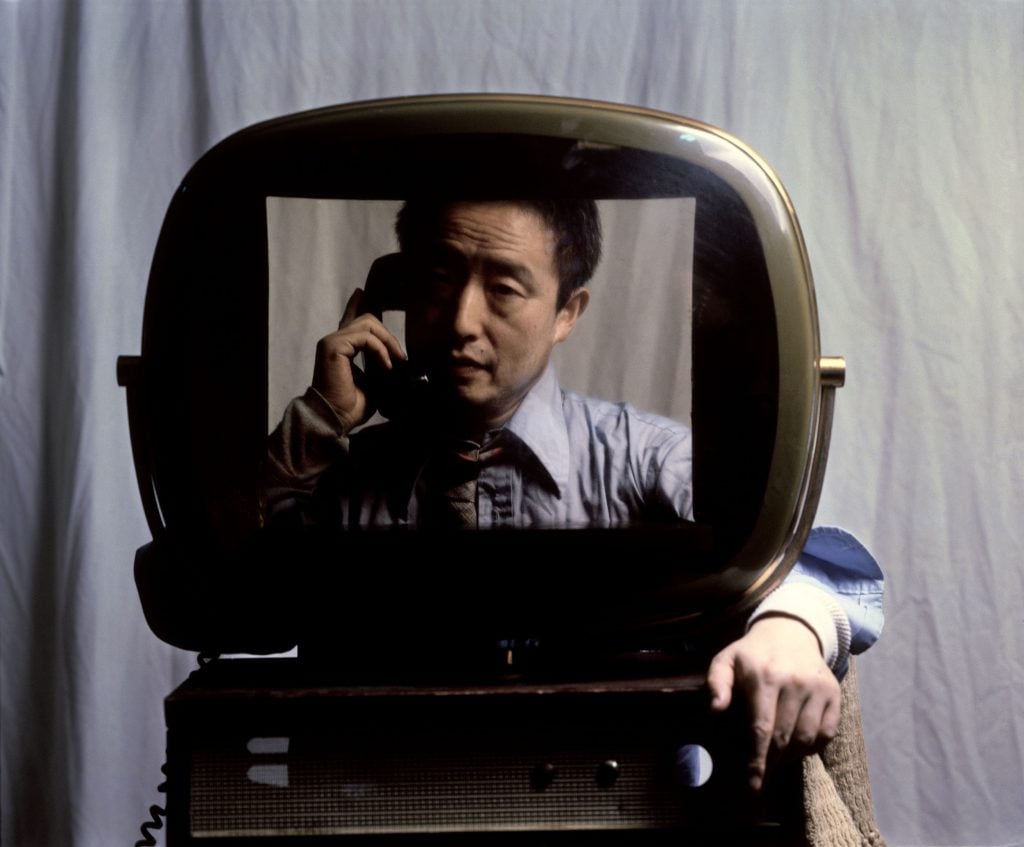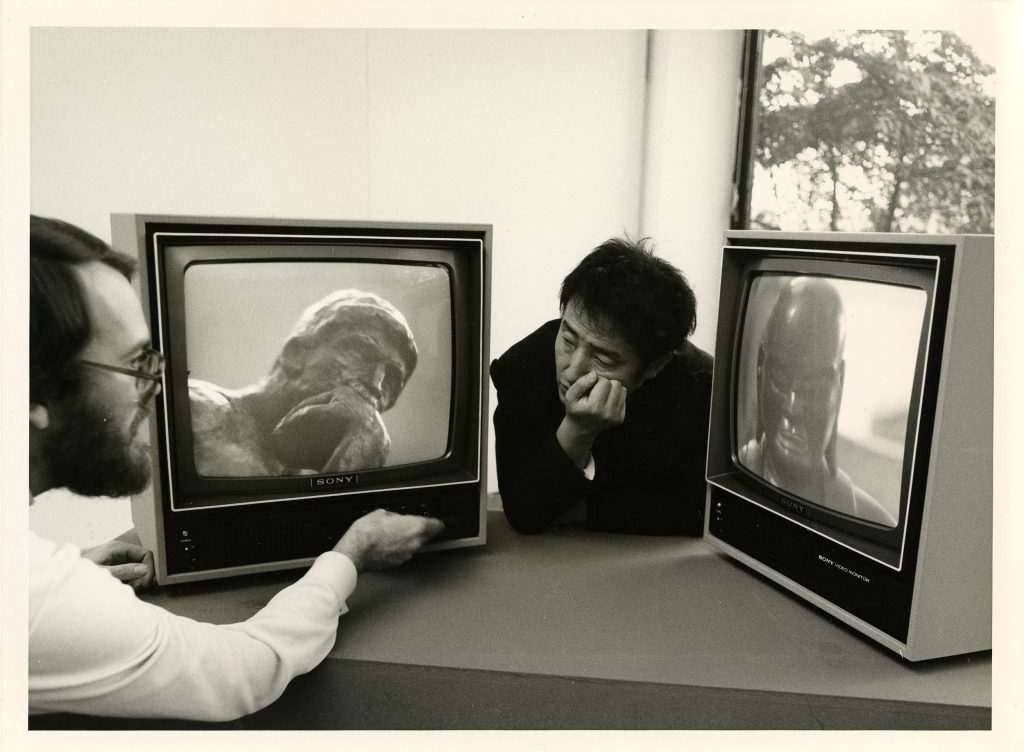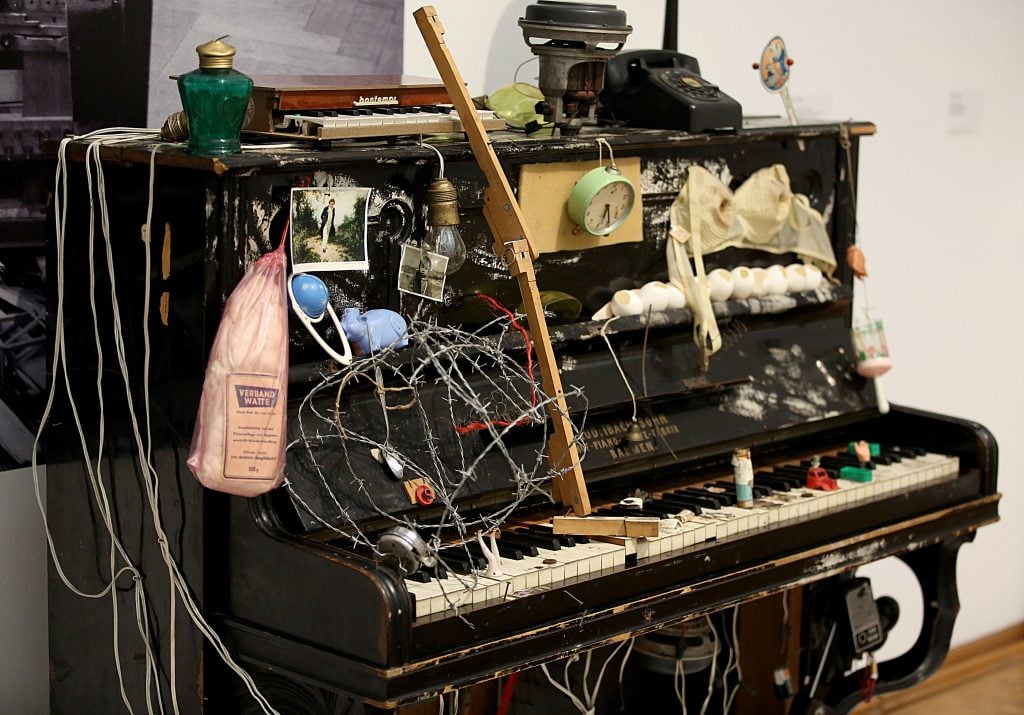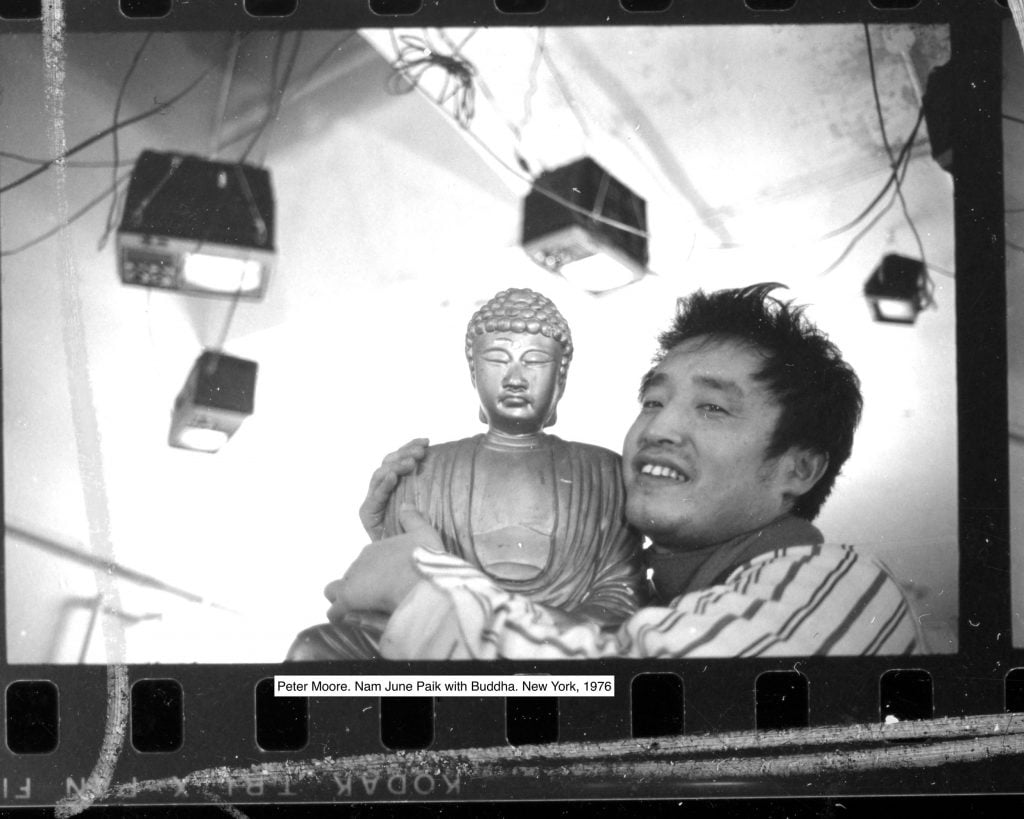Pop Culture
‘This Is the World Nam June Paik Imagined’: The First Documentary on the Father of Video Art Celebrates His Prescience and Sense of Play
'Nam June Paik: Moon is the Oldest TV' is screening at the Film Forum from March 24.

'Nam June Paik: Moon is the Oldest TV' is screening at the Film Forum from March 24.

Min Chen

The new documentary Nam June Paik: Moon Is the Oldest TV opens on a video screen displaying a geometric computer animation. Edged with primary colors, the graphic, shaped like a butterfly, moves in reaction to audio inputs provided by Paik. Leaning against the screen, he sings, hums, and coughs into a microphone, causing the video sculpture to dance and vibrate in response. It’s a scene that nails the essence of the artist long dubbed the Father of Video Art, for here, Paik isn’t just at work—he’s at play.
The film is the first to recount Paik’s biography and body of work, locating his origins in Fluxus and culminating in his monumental video works. Archival material and interviews with the artist’s peers and admirers (Marina Abramović, Ulysses Jenkins) are threaded throughout; a voiceover features actor Steven Yeun reading excerpts from Paik’s diaries and personal correspondence, most of which are collected in the Smithsonian.
What comes through clearly isn’t just the Korean American artist’s deeply considered approach to art and technology, but the subversive glee with which he undertook his calling. It’s this same quality that drew director Amanda Kim to Paik.
“He was so charismatic and so charming—he’s funny,” she told Artnet News. “He speaks in koans or haikus and there’s so much to unpack from just one sentence of his or one piece of work. Once you get past his sense of humor, he’s just brilliant.”
This was, after all, a classically trained pianist who took to smashing the instruments of Western music with Dada-esque delight; who built his first robot, K456 (1964), with spare mechanical parts as a way to “make technology ridiculous”; and who, with cellist Charlotte Moorman in the early ‘60s, staged nude performances in a bid to make string music sexy again.

Nam June Paik watching streams of TV Rodin (1976–78) and TV Buddha (1974). Photo courtesy of the Smithsonian Paik Archive.
Kim herself was first drawn to Paik by TV Buddha (1974), his most famous piece that installed a Buddha statue in front of a television set—a witty yet perceptive staging of a meeting between transcendentalism and technology.
“You look at his work and it’s so poppy. Some people think it’s kitsch, like it’s very happy and utopian,” Kim said. “But Paik was very critical; he could see the double-edged sword of these new technologies. He could see the ways misinformation could spread and the ways these technologies could be misused by greater powers. His hope was that we find more humane possibilities and positive uses of these technological innovations.”

Nam June Paik, Klavier Integral (1968–73), installed at “Art into Life! The collector Wolfgang Hahn and the Sixties” at the Museum Ludiwg, 2017. Photo: Oliver Berg/picture alliance via Getty Images.
But as Moon relates, Paik’s experiments with technology weren’t instant hits. His first show, 1963’s Exposition of Music-Electronic Television at the Galerie Parnass in West Germany, featuring a series of T.V. sets attached with magnets that altered the onscreen images, was unceremoniously panned. “Everyone from artists, critics, collectors, and museum professionals,” recalled German art historian Wulf Herzogenrath in the film, “they all slept on the birth of electronic art.”
It took TV Buddha to rocket Paik to mainstream and institutional attention (so much so that he made multiple iterations of the work) for his impish critique and artful eye on technology. That same decade also saw him unleash Global Groove, a 28-minute video that aired on public television. The work stitched together clips of experimental art, performances, and commercials, all distorted through a “video synthesizer,” serving up Paik’s high-spirited vision of an “artist-owned television program.”

Nam June Paik with Buddha, 1976. Photo: Peter Moore.
For the man who coined the term “electronic superhighway,” Kim noted, “Nam June was trying to make his work accessible by putting it on public television and not just keeping it in the confines of the art world.”
That accessibility has meant that while Paik has created a trove of tech-based works—from Video Fish (1975) to The More The Better (1988) to Electronic Superhighway (1995)—it’s Global Groove that has most resonated across popular culture. For instance, the documentary picks up on similar visual stylings between Paik’s work and music videos for “When Doves Cry,” “Once in a Lifetime,” and “Pump Up the Jam,” among others.
Paik’s sense of play further extended to his public persona, which, as depicted in the film, aimed to disarm and challenge people’s assumptions of him as an Asian artist working in America. “Depending on where he is, he will say he feels like a New Yorker when he’s there, or he feels ‘oriental’ when there are no Asian people around,” said Kim. “That was something he was so aware of—his place in the world and the environment he was in.”

Nam June Paik, The More The Better (1988). Photo courtesy of Greenwich Entertainment.
In fact, Paik’s lightheartedness masked the man’s anxieties, including the hardships of being away from his native Korea and the paranoia of returning to an authoritarian country. Paik’s family had fled Seoul for Hong Kong during the Korean War, a displacement that haunted the artist throughout his time in Munich and New York.
Moon includes footage of Paik’s first visit to South Korea in more than three decades in 1984, during which he feared being arrested for his “leftist reputation” (his friend Dan Foresta recalled Paik leaving him a phone number to call if he didn’t hear from the artist after two weeks).
In this light, it’s easy to understand Paik’s eagerness to deconstruct and destabilize an outsized force such as technology. And in doing so, he presented a way to address its existence, now ubiquitous, by leaning on wit to introduce insight. “I see his influence everywhere today,” said Kim, whose film is interspersed with Zoom interviews and TikTok videos. “This is the world Nam June Paik imagined.”
Moon is bookended by one of the last interviews Paik gave before his death in 2006. Asked how he’d like to be buried, the artist insisted on being cremated, with his ashes scattered “all over the world.” Where then should a funeral service be held? “Wherever,” he replied. “A cheaper place.”
Nam June Paik: Moon is the Oldest TV is screening at Film Forum, 209 W Houston Street, New York, from March 24.